About 5 years ago I was in a job interview for an elementary art position, and I told the art coordinator of the district that I hate the elements and principles of art. She was visibly shocked and needless to say, I didn’t get that job.
My website this month has been taken over by my elements and principles of art series which is in direct conflict to that statement I made to that art coordinator years ago. Why the change? Well, there isn’t that much of a change from my original position. I do still hate the elements and principles of art, but I have tweaked my position on this over the years. Let me explain.
This series has been very popular on my site and is bringing in some great traffic. I knew it would be super useful to a lot of people, but I just got wind from a fabulous art teacher that my elements and principles of art posts are adding to a bit of controversy on an art teacher group on Facebook (side note: please add me, admin, if you are reading this! I requested to join a long time ago, and it is still “pending.”). My response to her was, “I totally agree with them!”
This is a controversial subject with art teachers, so I hope you keep your opinions and comments respectful. You might disagree with me, and I’d love to hear your thoughts either way! 🙂
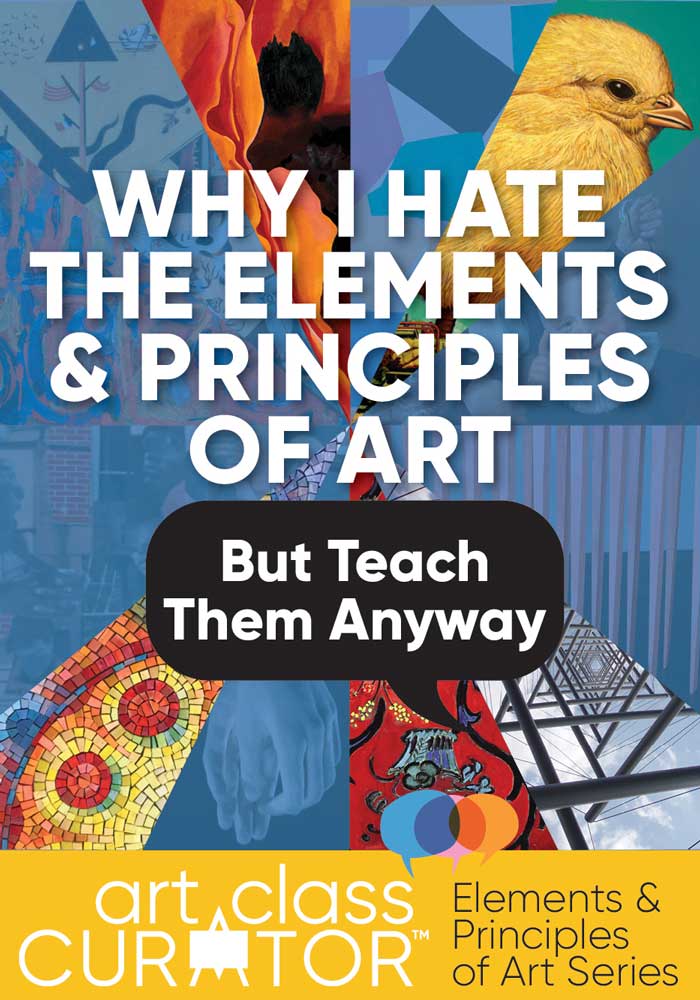
Why I Hate the Elements and Principles of Art
When you design a curriculum around the elements and principles of art, I believe you are doing the students a great disservice. Art is WAY MORE than just design. It’s about ideas and feelings and connections and creativity and all those wonderful things that we love. When you take all of that away and just teach zigzag lines, you are taking away all that art is and leaving nothing of value.
Another aspect that bugs me about the elements and principles of art is that they are a crutch. They are a way that art teachers can prove to math teachers that we too have “real content.” I hate nothing more than hearing an art teacher try to justify the importance of art teaching with an elements and principles argument. No, just no.
“Look! Art is real! You just don’t know! Line, Color, Rhythm! It’s a real thing! My subject is just as important as yours!”
Yes, elements and principles are real teachable content, but they are not why art is valuable. They are tools to make better compositions, but they are also tools to help make meaning. An artist doesn’t just choose to use contrast in order to make something look better. They choose to use contrast to make a statement, to make us think, to make us feel, etc.
Why I Love the Elements and Principles of Art
Well, love is a strong word. I don’t love them. I hate the elements and principles of art, yes, but I do still teach them. Here’s why.
Take The Starry Night–one of the most famous paintings ever (famous is another thing I hate, but that is a story for another day). It’s amazing and beautiful, and it makes us and our students feel something when we look at it.
But, why does it do those things? What choices did the artist make to us feel the way we do when we see this painting? That’s where the elements and principles come in. The artist used swirling, flowing lines, and movement that captures the feeling in my heart when I am very emotional. He used proportion in the art to make that cypress tree grab our eye and flame up and flow back into the sky so we keep looking. He used contrast to make the moon and stars pop out from the sky. Van Gogh used the elements and principles to convey how he felt, and it impacts us in powerful ways.
Our feelings when we look at art are not accidents. They are deliberate choices made by artists.
To me, the elements and principles are about visual literacy.
In our world, images bombard us daily and most of them are advertisements. People use the elements and principles to manipulate us daily, and kids need training in how to see those things. Teaching kids how to notice the choices people make when they make images help them be more informed and aware of their surroundings.
Knowing the elements and principles also helps us better appreciate and connect with works of art.
The Elements of Art and Principles of Design as a Tool
I really dislike art curricula that divides a year into 6 units with each one focusing on one of the elements or principles of art. You study line, show some examples of line, and then you do an art project where you use line. Not for me.
But, design is a part of art too. Learning how to make choices in your art that better communicate your meaning is an important element. I do believe if you focus only on line, you could be stifling your student’s creativity, but you also can’t leave it out altogether. The elements and principles need to be taught as a tool that students use in their art just like they need to be taught about the tools of paintbrushes, drawing implements, clay tools, etc.
How I Personally Teach the Elements and Principles of Art
I primarily teach art history and art appreciation, so I may be in a different situation than you. I usually cover them all over the course of maybe 3-5 hours of lessons usually nearish to the beginning of the course/semester (depending on how long the classes are and stuff) and then hit them occasionally throughout other lessons (like covering perspective/pyramidal configuration with the Renaissance, diagonal line/value/contrast with Baroque, etc.). I also heavily include art criticism exercises in my lessons, so students are regularly picking apart artwork in my classes. Covering the elements and principles at the beginning gives students a basis for understanding and looking and trains them to keep looking.
So, there you go. That’s my full opinion on the elements of art and principles of design. What do YOU think?
Download the Free Elements and Principles Printable Pack
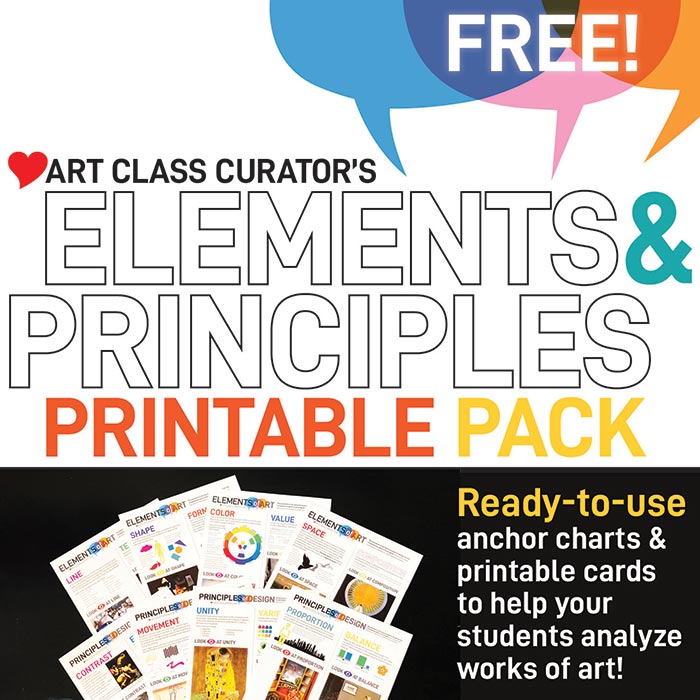
This pack of printables was designed to work in a variety of ways in your classroom when teaching the elements and principles of art. You can print and hang in your classroom as posters/anchor charts or you can cut each element and principle of art in its own individual card to use as a lesson manipulative.

Free Resource!
Elements & Principles Printable Pack
The Elements & Principles of Art are the foundation of every artwork, but teaching them can be a bore. Wake your students up and engage them with full color artworks, easy to understand definitions, and thought-provoking higher level thinking questions. This versatile resource can be hung in the classroom or used as an art manipulative.
Mentioned on the Art Class Curator Podcast…
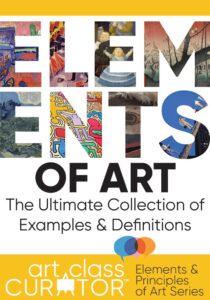





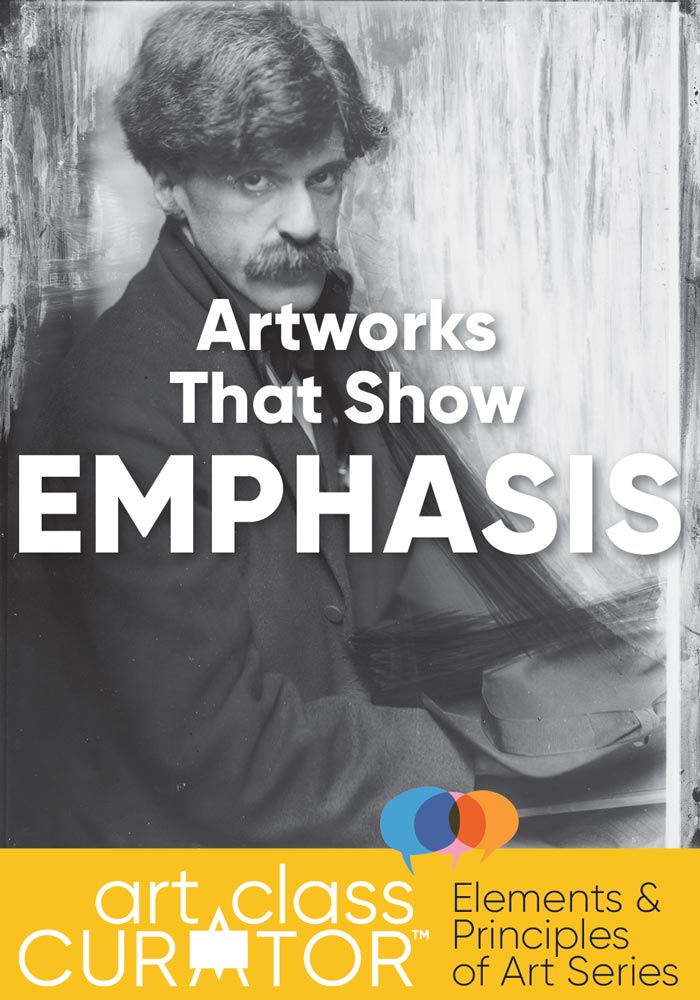

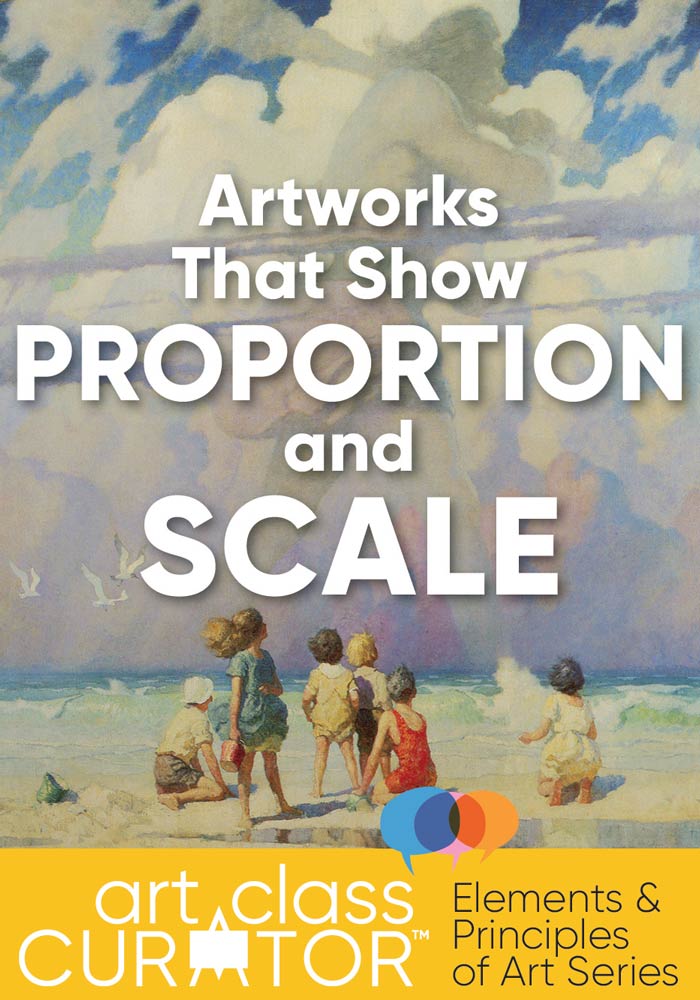



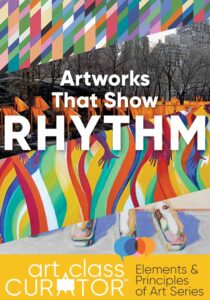


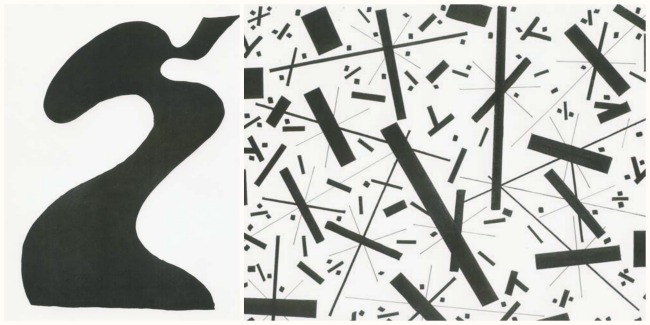

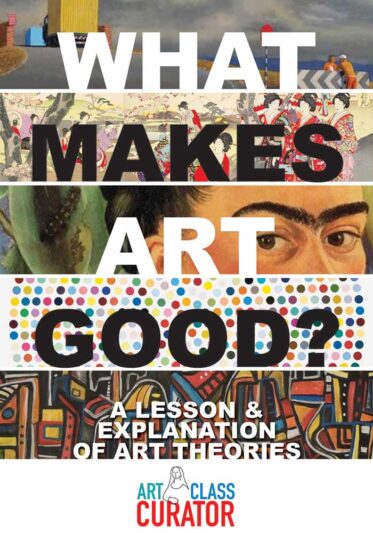


I agree and have had to adjust my curriculum over the years due to District policy. It seems art that has meaning has been discounted. It is disheartening to teach el and p only. In my district emphasis is no longer on intention or content. Drawing isn’t taught anymore because a student can use an overhead projector. I see technically well done work with no “life”. Sad. Retiring I’m done now.
Ugh, that is so sad! 🙁
So sad! I work for Virginia Beach City Public Schools and I love my job! Yes I am strong on teaching the principles and Elements but in CONJUNCTION with
historical happenings, information on the artist and scientific discoveries of the time; even questioning how the environment might have been different from today.
Art to me is so important as a way of understanding humanity and social ideas as well as private response to the world around us!
Sooooo agree. Thank you!
You’re welcome! 🙂
I DO teach e & p every year at the beginning of the year. I explain it to the kids that the elements are like the ingredients of a cake, that you need them to make successful art, and the principles are like the directions of how to put them together. I do this because my class is the first time most of my students get any formal art class and, although they like to draw, I feel it is improtant that they know WHY what they draw works (or doesn’t) and how they can use these tools to improve. It’s like teaching a foreign language…you wouldn’t start them on reading literature in tha language without eaching them vocabulary and sentence structure. I understand what you’re saying, but I feel it’s improtant to teach basics before I move the students onto other projects. Mind you, I rarely spend more than 10-12 weeks on e & p, but I DO cover them fairly well.
Thanks for your comment. I agree with you. I do the same thing; I teach them at the beginning as basics and incorporate them throughout other lessons as well as they fit.
I totally I agree! Its a starting point, a foundation . Also this CHOICE BASED ART is another issue…if the students have not been exposed to the elements and art processes…they struggle where and how to start a work of art. I have Free choice art classes as a reward for good behavior. I watch many struggle with this issue. I often need to give them ideas. As far as proving our worth in education…it has existenced throughout my 35+ career….that is the saddest of all. I have learned to shut the door and leave all the politics and negativity in the hall!
Wishing you a wonderful year!
I think that if you look at it from the direction of teaching the elements and principles then you are going at it from the wrong direction. Art is about history and sociology and math and technology. That is how I teach it anyway. Art is a reflection of world events past and present and how society reacts to those events. All of my lessons are based on that concept. Once that concept is introduced for each lesson then I plug in the elements and principles of how to do “effective” art which relates to the original concept. It takes the blah out of it and introduces higher order thinking.
Thanks, I totally agree!
We can have best of both worlds. I teach middle school grades 5-8. I teach e & p by incorporating them into lessons where we look at art works and discuss how the p & e are used in them. We discuss why the artist made the choices to use certain e & ps, or why they chose the specific materials and techniques, and how those choices helped to express what the artist was trying say.
E & P give us a common vocabulary to discuss art and to understand why visual images are effective or not. Students can use this knowledge to experiment in their own work. I feel like I should give my students the tools to create, and then they can have total freedom to choose. Personally, I think if I hadn’t been taught the e & ps back in the day, I’d have been frustrated by not really understanding why some of my artistic choices worked and some didn’t, or being limited by having no clue of what my options were for achieving what I was imagining from a technical/design standpoint. Creativity happens different ways for different artists, and sometimes the e & ps give us a road map for to how to get there.
I am a musician as well as an artist. A long time ago, I did an audition where the jurist said that I had “all the things that can’t be taught” (passion, emotion, etc.) but I was limited by my technique and musicianship (or lack thereof). He explained that if I improved my technique and understanding of music theory, my expression of the music would be so much more effective. He was right. I didn’t sacrifice my expression and creativity by learning about fundamentals, it freed me to make better choices and perform on a higher level in every aspect. I have found this can apply to visual art, too.
That’s a great analogy! I think that’s ultimately where I turned around on them and make sure I cover them in the beginning and throughout the course. I know they are very valuable, but I do think they are relied on too heavily in a lot of cases. Another distinguishing factor here is that I am an art appreciation/art history teacher, so the teaching the skill/making part of art is not something I have to do in the classes I teach, so I have some more freedom there. 🙂
i teach E and P at the beginning within the first week within a progressing nonobjective design project. I focus on letting them know this is to teach you a vocabulary that we will use when discussing composition throughout the rest of the class. Without students having this vocabulary it is difficult for them to articulate what they like about a composition besides I like it because it looks cool. It also helps to clarify the difference between focusing on composition from content and craftsmanship. We can only talk about a subject to the depth of our vocabulary. You don’t have to let E and P be an anchor, cover the basics and let them be building blocks for later discussions. How else do you talk deeply about composition without these words?
Absolutely, I do the same thing! It’s not something you can leave out.
That’s fascinating! Thanks for sharing. It sounds like there are a lot of parallels here! Side note: I’m actually planning on doing a post about art and music integrations in the future. 🙂
I do like to develop a vocabulary for my students to be able to discuss all manner of art and art-related concerns. I went to a very avant-garde university, and love the thrill of engaging in the making of art in larger contexts than pure design concerns. I do however see the value of uniting the art- making basic concepts and vocab so students may have the freedom to soar even higher when expressing ideas. Seems that there is a war on anything that seems traditional in the art room, but the pendulum seems to swing too far in either direction depending on the times.
Yes, I agree! There needs to be balance.
I think what you are talking about are two completely different things. Knowing and understanding the Elements and Principles of Art does not make students artwork have less meaning.
Being a prescriptive art teacher is what handicaps student artwork in my opinion. Allowing students to experiment and learn from their mistakes, teaching them that their point of view matters is what gives meaning to their art. I think what you are getting at is that technique can take over creativity, but the Elements & Principles of Art aren’t technique. I teach my students that art has a language. That they can learn that language to enable them to communicate through their artwork.
I hate the word “talent” or treating art like it is some “mysterious or magical” process. It’s not. It’s hard work. It’s making mistakes and turning them into something beautiful. It’s finding your own answers to problems. It’s the expression of ones heart and mind and soul. Understanding the foundations of Art Cani only help in this endeavor. Not liking the Elements and Principles of Art is like saying as an ELA teacher that you don’t like grammar, structure, plot, character development, etc. knowing these things makes you a better writer. Knowing the Elements and Principles of Art makes students better artists. Period. Without question. It builds their confidence and when they learn to apply this knowledge in their own expressive works of art the results are fantastic.
I couldn’t agree with you more. Believing that the Principles and Elements are a crutch is like telling a doctor that the stethoscope around his neck is a crutch. P & E are tools, building blocks, and characters of a language that give shape to the world in which the art student and the art teacher engage.
The creators of this website would do well to better understand these tools for themselves, as the look and feel of this site is rather uninspiring.
YUP, I TOTALLY AGTREE , they are the tools that artists work with. Students need to be aware of them when looking and critiquing art as well as when they are making art. No push back from . I teach pottery and Fiber Arts at a public HS.
Teaching elements and principles and letting them drive curriculum are two different things as many of your readers have pointed out. Yet just today I’ve seen a couple of facebook posts where el & P are the thing teachers are teaching. Designing our curriculums around them is an outdated idea, created nearly 100 years ago to talk about Western and modernist work. Consider contemporary modes of art making and have students investigate ideas that are meaningful to them.
Couldn’t agree more! Thanks for your comment. 🙂
I agree with the metamessage, in that way I also have a love/hate relationship with this particular part of teaching. E&P of Design art essential to get your message across, because no one wants to look at ugly art. I like to say all good art has two of these three: good design, good content (or concept) and good craftsmanship; it is even better if it has all three. Without at least two legs to stand on, art will often fall short of doing what it is supposed to do. Bad craft and content, cannot hold up with great design. KIDS hate the E&P of design if they do not get that you as a teacher do not believe that they are the end-all-be-all of art, because they all know they are not. They are just a good tool to use and know, but there is a lot more to art. All artists know this. All art critics know this.
I love this! Now that I am back in the classroom, I am finding them especially useful when talking to kids about their art.
The reason I feel so many districts rely on their art curriculums focusing on the el and p of art is because most educators do not understand our subject. They don’t know how to read art, create art or teach art…but they have something to “grab” onto when looking at the el & p of art. Kids on the other hand just want to create. For the most part, I find most children K-6th grade love art and love to produce art. When introduced creatively, the Elements and principles can lead to exciting results coupled with art history, imagination and encouragement!
The post & threads about E & P are helpful for me as I prepare an art docent lesson for my 2nd grade granddaughter’s class. This isn’t my area of expertise so I feel like I prepare endlessly. Art docent preparation as art education! Use of the internet has certainly changed things from when I volunteered as art docent in my children’s classrooms. (Less danger of over preparing back then though.
Here in Western Australia our art curriculum is focused on arts ideas and exploring ideas and materials in different contexts. Arts elements an principals are included but I totally agree with you – they are a part of visual literacy giving us the vocabulary to discuss the ideas and meaning of art works and how the artist achieved their purpose.
I agree with you. I strongly believe art elements and principles are part of critical visual literacy and teaching the “language” of art. I use philosophy for children to analyze art – I see… I think… I wonder…. (Making Thinking Visible routine) this way the children navigate themselves around the chosen art and their own art in a way that is meaningful.
Hello, I don’t “teach” E&P as a lesson or vocabulary, but I make them part of the goal of a lesson and and often check for understanding. Hopefully the students naturally start using this language without being told to. If they miss it , I move on to the next lesson and place a stronger emphasis on the vocabulary I’m using. If I tell them I’m looking for “contrast” they tend to make art to please me and overlook a good concept or a good composition. I try to make it natural. If I coach a soccer team I would never start by saying, “This is the goal line. Look up the definition of goal line because I’m going to test you on what that is.” Just speak passionately about your subject and they will understand the the importance of the vocabulary..
I do the same with my middle schoolers. It comes up regularly in their artmaking so I take advantage of those opportunities–especially contrast and balance!
Strange but I’ve always hated the elements for very different reasons.
My viewpoint is very heavily rooted in art-making and the elements become important ingredients in an educational setting.
They help quantify things that are hard to quantify.
What started out as me building a web resource for my students resulted in me completely restructuring the elements into a more proper hierarchical order:
Read if you dare: http://helloartsy.com/elements-of-art/
…and let me know what you think
Excellent! Your way makes a lot of sense.
I’m glad you think so Cindy. I know some of this stuff can get pretty heated… especially when it comes to art. Much passion in art 🙂
Yes, lots of online drama in the art teacher world, especially around the elements and principles!
I teach the elements and principles review in one period at the beginning of the semester. We make a sandwich together. I explain that the ingredients are the elements and principles. I have a student volunteer and then have them wash their hands and they hold out their hands and I begin to put on the ingredients. As I’m adding things usually starting with line and then shape etc. I ask what can you make with eggs sugar and flour and they list a ton, and then I ask why they all turn out different? After we start making a sandwhich in the hand without bread we spread the mayo and mustard on their hands then add ham and cheese as I’m showing pictures and explaining the power of each ingredient. Then I ask if I should put peanut butter on the cheese and of course nobody want than on there it would be nasty. So we explain that we may not want a lot of pattern and repetition on a piece of art. It might work with another piece or sandwich etc. Then we get done and I ask them if it looks good and appetizing, and they say they are missing the bread. Then I pull out the bread and proceed to put it between to slices. Just like a sandwhich needs good presentation so does art. We talk about how we present finish, frame and exhibit our work etc. Kids love it because it’s funny and they remember it and the simple concept of it.
That is SO GOOD! I love that. If you are ever interested in writing a guest post about this for my site, I’d love you to!
I love your position and could not agree more. I have tried to start this conversation yearly at our in service trainings at our local art museum, but other teachers just roll their eyes and say we just have to prove we are teaching something concrete so why bother discussing it? I disagree and want to explore curriculum design in a more abstract way, but get too much negative feedback when I do. Thank you for giving me hope it is possible to have this conversation and it is very much worth discussing.
Yes! I hate that we are forced into that “we have to prove ourselves” thing. Good luck fighting the good fight. 🙂
I’m so glad to read this! I teach a small class out of my home. I am making up my own stuff and since it’s private, nobody tells me what I have to do! I want the kids to know el & p so they have a lens to understand what critics say about a piece, but I tell them that Mr. Kandinsky would want to know what they felt when they looked at a piece. I also tell them the tricky part is sometimes you don’t feel anything until you understand something about art and so we need to know el & p’s so we can speak the language and appreciate what the artist might be saying.
I totally love this. I don’t teach, and at 46 years old earlier this year I discovered art as my true passion as a result of getting involved with art therapy because of my combat related PTSD. I’ve been creative all of my life, but I never even thought about art, and when I got into it, I was a natural. I even rented an art studio right before this summer because I knew art is what I was meant to do. The only issue I’ve had is not knowing how to describe anything art related as I never learned any art vocabulary alongside elements and principles, but thanks to your article I have become familiar with el & p’s and I am going to learn them myself because I know my art will only get even better. Thank you.
I completely agree with you! I hate them! But my district says I have to TEACH them in this hugely annoyingly structured sort of way. It makes me feel like I’m sure English teachers feel when they teach poetry via iambic pentameter—-like just kicking poetry to death and dragging all the passion out of it. I think I will now adopt your dealio—do it all in two or three hours and refer back over the semester. My kids just want to make art…they could care less about the e and p.
I like the arguments made — the ingredients should be understood but creating and appreciating art is much more than mixing ingredients together. I’m teaching Art ESL in China (Gr 1-6), and so it is a challenge to have any complex discussions due to their low level of English. Hence I tend to stick close to E&P and simple art techniques in order to teach them relevant English words for their future. I wish I could delve into the motivations of artists for the older Grades 4-6, but I struggle with how to simplify this without losing it’s subjectivity and depth. I’m going to try some lessons focused on emotions and expressing their reactions to various art. Any advice appreciated.
YES!!!!
Say it again for the people in the back!!
I teach middle schoolers, who decide before they even step foot in the door that they are bored. So let’s show them some shocking, amazing, intriguing images, and sneak a lesson in perspective in!
You’re right on, sister. Standing O for you. 🙂